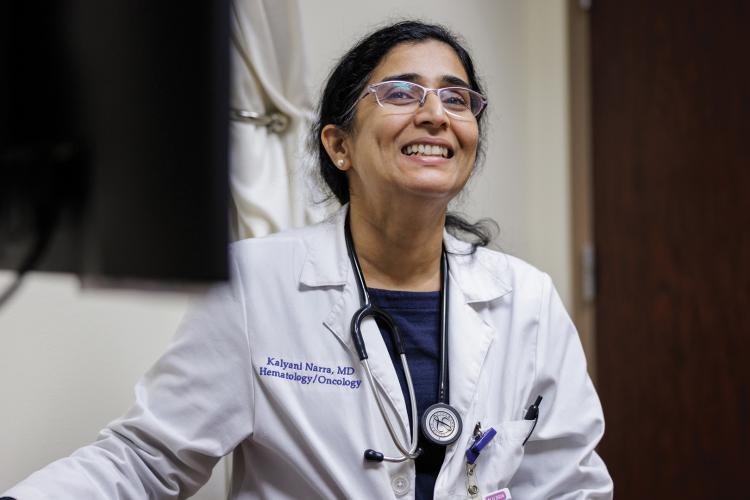
Breast cancer is one of the most common cancers worldwide, but it’s also one of the most treatable. With advances in screening, treatment, and awareness, more people are surviving and regaining their quality of life after their diagnosis. We sat down with Kalyani Narra, MD, Oncologist at JPS Health Network, to talk about the realities of breast cancer, from risk factors to prevention, and what she wishes more people understood.
What is breast cancer, and what’s the most important thing to know?
Breast cancer is a disease that has multiple types and stages. “The most important thing I would say is that treatments are available no matter what stage patients present in,” said Dr. Narra. “There are multiple varieties of breast cancer, but for any type, we have treatment options. Patients should seek care and not hide it.”
Breast cancer is often categorized into three main types:
- Hormone receptor-positive (HR+)/HER2-negative:
This is the most common type of breast cancer. The cancer cells grow in response to hormones like estrogen or progesterone, but do not have high levels of the HER2 protein.
- HER2-positive:
These cancer cells have too much of a protein called HER2, which helps them grow faster.
- Triple-negative breast cancer (TNBC):
The most aggressive form of cancer, which is often seen in younger patients and Black women.
Staging depends on tumor size, lymph node involvement, and whether the cancer has spread. Doctors also consider tumor biology, such as hormone receptors, when creating treatment plans.
What are the biggest risk factors?
According to Dr. Narra, the single biggest risk factor is simple: being a woman. While men can get breast cancer, cases are far less common.
Other risks include:
- Genetics: About 10 percent of breast cancers are linked to inherited mutations like BRCA1 and BRCA2. At JPS, that number is higher, around 25 percent of patients with triple-negative breast cancer carry a genetic mutation.
- Age: Most breast cancers occur after menopause, though JPS often sees aggressive cases in women as young as their 20s and 30s.
Still, for the majority of patients, no clear risk factor can be identified.
What are the early warning signs people overlook?
The most common sign is a breast lump or mass. According to Dr. Narra, it is vital not to ignore a lump even if you’ve had a recent mammogram because even with a negative mammogram, guidelines often recommend further imaging or sometimes a biopsy. This is because physical findings can sometimes be more telling than scans alone. “I’ve seen women who had a normal mammogram but developed a mass just months later that turned out to be cancer,” said Dr. Narra.
Other signs may include changes in breast shape, skin dimpling, or nipple discharge. Dr. Narra stresses the importance of paying attention to your body and speaking up if something feels different.
How is breast cancer diagnosed or screened for?
The gold standard for screening is the mammogram, typically recommended to start at age 40 – 45, depending on the guidelines. At JPS, women can access mammograms even without insurance through partnerships with Moncrief Cancer Institute and UT Southwestern.
If an abnormality is found, follow-up steps may include diagnostic imaging and a needle biopsy, which allows doctors to test for hormone and HER2 receptors. “Excision biopsies used to be common, but the standard now is needle biopsies,” Dr. Narra explains. “They give us the information we need to guide treatment without performing a surgical breast biopsy.”
What are the most effective prevention strategies?
While no one can completely prevent breast cancer, healthy lifestyle choices can help lower risk. This includes maintaining a healthy weight, regular physical activity, and stress management.
For women with genetic mutations like BRCA, more proactive steps may be recommended, such as preventive mastectomy or ovary removal once family planning is complete. Genetic counseling and testing are available through JPS in partnership with UT Southwestern.
What role does lifestyle play?
Lifestyle choices can support both prevention and survivorship. “Staying active, eating well, and reducing stress are helpful,” said Dr. Narra. “But it’s also important to understand that some women do everything ‘right’ and still get breast cancer. That’s why screening is so critical.”
What’s one thing you wish more people understood?
“I still see stigma associated with breast cancer, and I see patients, women and men, waiting far too long to seek help,” Dr. Narra said. “Breast cancer is not a death sentence. There are more survivors of breast cancer than of any other cancer. No matter the stage or type, we have treatment options, and we have clinical trials at JPS.”
To learn more about the Oncology Services offered at JPS Health Network, https://jpshealthnet.org/get-care/services/cancer.
